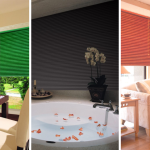Window blinds are not usually something that you consider as an item that makes or breaks the interior design, but they are one of the most important elements for setting the mood of the room. Whether you choose Roman or Venetian blinds, selecting the right paint colour and style of your blinds can add that touch that completes the look. If your next question is what colour blinds go with white walls, we have some news that might surprise you.
Setting the Tone
It seems that everyone’s first instinct is to be conservative when it comes to blinds. White is the most common colour choice, and in some cases, this is the perfect colour match. If you have white walls, then white blinds could make the space look larger and draw attention to more colourful accessories. White walls with white blinds are a clean look, if you’re willing to take the risk, there are more interior design choices you can make.
When it comes to blinds, most people focus on the colours of the curtains, considering the blinds to be an afterthought. If you use Accent Blinds to pick up one of the colours of the drapes or curtains, you have suddenly taken full advantage of your windows as design real estate.
Light and Texture
The purpose of window blinds is to manipulate the light in your room, but they also add texture. If you still want to keep the light and airy feel of the room, you can choose blinds that are lighter in colour and that allows some of the sun to filter through. You can also use them to exclude light entirely, as you might wish to do in a bedroom. The amount of light that they allow is one thing to think about before deciding on your blinds.
The texture is another consideration. Blinds come in many different materials and textures. You can choose cloth, real wood, vinyl, or exotic materials, such as bamboo. You can select the surface of your blinds to match other textures in the room. Layers of texture are a more recent trend and using blinds can add another textural element to complete the look.
Adding a Touch of Drama
Matching the colour of the blinds to the curtains can give the room a finished look, but you can also use blinds to add a bit of drama. Consider using vibrant colours, such as red or jewel tones, to add colour in an unexpected way. This is the perfect way to top off a Boho Chic or eclectic design style.
If your style is minimalist or perhaps more contemporary, adding black or grey blinds can give it a modern feel. You might try adding an accent, such as a lamp or accessory, in vibrant colour and then matching the blinds. Using blinds in this way makes them more than part of the building, and they now become part of the design scheme.
Subtle Accents
Blinds can be used to add drama to the room. They do not have to just fade into the background. You can also use them to enhance the colours of the room in a more subtle way. One way is to choose colour match paint in the exact shade of the blinds. This will make the blinds look as if they are part of the wall. This would be an excellent way to use blinds as the only window treatment.
You could also choose to pick out subtle shades in the décor scheme. For instance, you could use the blinds to pick up neutral, earthy tones in throw pillows or other accents in the room. This would allow the blinds to give the room a finished look. In some neutral colour schemes, white could make the space appear stark. They might be too bright. In this case, a neutral colour blind would create a more peaceful, harmonious feel.
Final Tips
Now, you can see how the choice of colour in blinds can enhance the design scheme in ways that you never expected. Here are a few tips for choosing the right blinds.
- Avoid choosing a blind colour that isn’t used elsewhere in the room.
- Light colours tend to make the room look larger.
- Dark colours can make the room look smaller.
- Matchwood tones in terms of light and dark woods in the room.
- Step back and look at the whole room from a distance.
- Consider the blinds as you are choosing your colours and accessories.
You can choose to make the window blinds play a supporting role or make them part of the main attraction. The most important thing is to consider them as part of the entire design rather than as an afterthought.


